INNERMOST SECRETS OF MXA’S PERFECT VET MC366 PROJECT RACER
 It’s a clean machine. Unlike most project bikes that looked like glistening anodized baubles, every part on MXA’s 2023 GasGas MC366F was chosen to do a specific job—right down to the Husqvarna shock linkage and one-off Cone Valve forks.
It’s a clean machine. Unlike most project bikes that looked like glistening anodized baubles, every part on MXA’s 2023 GasGas MC366F was chosen to do a specific job—right down to the Husqvarna shock linkage and one-off Cone Valve forks.
BY JODY WEISEL
Lack of money, nagging injuries, an angry wife, the college fund, truck payments, T-ball games, braces for the kids, a mortgage and ever-advancing age are the enemies of the glorious pursuit of motocross racing. By luck and happenstance, I don’t have any of those problems, save for the one that I can’t do anything about—getting older.
Age-related barriers to racing motorcycles don’t just start as you ride into your golden years. Lots of Pee-Wee riders are stymied by the daunting task of learning how to shift and use the clutch at 10 years old. The majority quit riding in the face of the four-limb paradox. Teenagers aren’t immune to age-related hurtles, because, in most cases, Mom and Dad were willing to foot the bill for bikes and parts when Junior was a wide-eyed kid, but once he became a pimple-faced, rebellious teenager, they cut the motocross cord. Eventually, no matter how hard you try to fight it, the work or college equation comes into play in your 20s, followed by girlfriends, wives, alimony, child support and ushering Mom and Dad into the Quiet Acres Retirement Community in Coral Gables. The fabric of life is woven from all colors of thread. Motocross racing is just one small part of the big quilt.
“I AVOIDED THE MAJORITY OF THE ROADBLOCKS TO MY LIFE AS A MOTORCYCLE RACER, THANKS IN NO SMALL PART TO MAKING MOTOCROSS THE PRIMARY FOCUS OF MY WORK, RECREATION, FAMILY AND MENTAL HEALTH.”
I avoided the majority of the roadblocks to my life as a motorcycle racer, thanks in no small part to making motocross the primary focus of my work, recreation, family and mental health. I was lucky in that except for one used Benelli Riverside 125, I never relied on my parents for bikes, parts, entries or gear. Additionally, Lovely Louella came from a motocross family. I bought my house with cash. I drive a 14-year-old truck, and because of my work as a test rider for Motocross Action, I never had to worry about where my next bike was coming from.
However, I couldn’t do a blessed thing about getting older, crankier and more irascible. The machines I flew on a few years earlier (okay, maybe a few decades earlier) suddenly had flaws that I couldn’t live with. They were too tall, too heavy, too loud, too twitchy, too stiff or too soft. It was the test rider’s curse. I could not stop being a test rider long enough to enjoy the ride.
“WHEN IT CAME TO THE ENGINE, I HAD A VERY CLEAR PLAN IN MIND. I WANTED TO MAKE THE UNTOUCHED 2023 GASGAS MC350F INTO A BIG-BORE MC366F.”
There were two solutions to avoid becoming a motocross curmudgeon.
(1) Quit racing. There is no shame in that. I had started racing in 1968 and have never stopped. Everyone I raced against had already quit, died or were on wife number three. I have raced almost every weekend of my life, and even if I only raced one class or one day each weekend, that would still add up to 2750 races. But, I had raced Saturday and Sunday every weekend, often two classes per day, and since this was Southern California, I could race as often as four times a week if I raced all the weeknight races. But, as I got more mature, grayer and slower, I cut back to only one class per day, one day per week and no night races.
(2) Build the perfect bike. I don’t mean the perfect bike for you, but for me. Well, actually, I was building it for my friend Kent Reed, who financed the whole project, but told me to build what I wanted and race it until he was healed up from his most recent injuries and ready to take it over. Yes, it would be my own personal statement, but Kent was good with that because I had built him a couple bikes before. This one would be a special edition—without the compromises. Back when KTM first announced the 2011 KTM 350SXF, I was hoping for a mid-size 450, not an upsized 250—something along the lines of the 2010 KTM 400XCF or the original 1998 Yamaha YZ400. I envisioned a bike that was lighter and more agile than a 450, but with a broad, easy-to-use, torquey, mid-sized powerband—not a big-bore 250 that had to be revved to 13,400 rpm to get max power.
What follows is a breakdown of the brand I chose, the displacement I chose, the suspension I chose, and the parts I chose to achieve the greater good. As always at MXA, money was no object (because it was Kent’s money in this case). However. I did reuse as many old parts from Kent’s previous race bikes as possible—and that includes the forks, shock, skid plate and exhaust—even the Vortex black box was recycled.
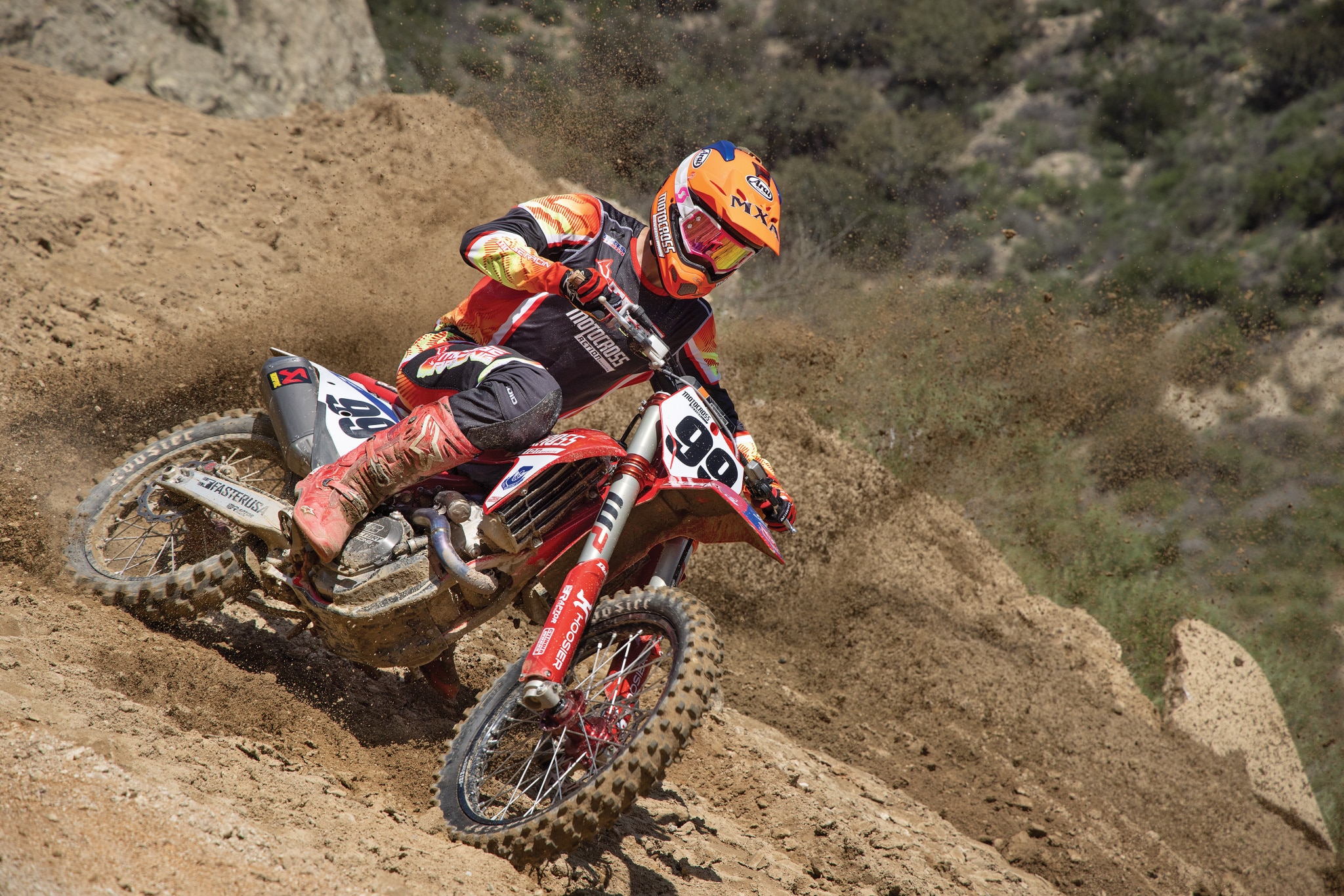 The key element was the Cylinder Works 366cc engine kit. It is the cheapest way to make big power. Even better is that it positions that power directly in the sweet spot of the powerband. There was no need to rev to 13,000 rpm to get max power.
The key element was the Cylinder Works 366cc engine kit. It is the cheapest way to make big power. Even better is that it positions that power directly in the sweet spot of the powerband. There was no need to rev to 13,000 rpm to get max power.
THE CLOSER TO PERFECT, THE BETTER
In 2011, KTM didn’t give me what I wished for when the released the first 350SXF, but the subsequent KTM 350SXF, Husqvarna FC350 and GasGas MC350F have all been embraced by Vet racers, play riders, trail riders and cross-country racers alike as the best all-around race bikes made. Even the MXA wrecking crew believes that the 350 does a good job of bridging the gap between the 250 and 450. It allows riders who would like a stronger 250 or a mellower 450 a place to hang their hats.
But, regardless of how much I liked the trio of 350s as they were, I craved the opportunity to build the perfect Vet bike. I knew exactly where to start. I needed a stand-alone, brand-new, GasGas MC350F. That is where AEO Motorsports in Temecula, California, came in (with the aid of Kent Reed). AEO is one of the most aggressive KTM, GasGas and Husqvarna dealerships in SoCal, aided in no small part by their proximity to the Austrian brand’s headquarters and their in-house AMA Supercross team. It was the source of the GasGas MC350F I chose, along with many of the aftermarket parts I used. If I was building the same GasGas right now, I’d still want to start with the older 2023 GasGas MC350F because it much lighter, resilient and manageable than the 2024 version.
MAKING THE MOST LOGICAL ENGINE DECISION
When it came to the engine, I had a very clear plan in mind. I wanted to make the untouched 2023 GasGas MC350F into a big-bore MC366F. Over the past two years, I had tested MXA’s Cylinder Works-kitted KTM 366SXF, Andy Jefferson’s 2022 GasGas MC366F and David O’Connor’s KTM 366SXF. Each of them was in a different state of tune, but all of them were incredible to ride. The 366 engine felt considerably beefier off the bottom than the 350 engine. The added bonus of more displacement, even just 16.3cc more, resulted in power in places where the stock 350 engine was at its weakest. The 366F hit with a very broad rush of power. It felt very hooked up, was blessed with more torque, and could pull the next tallest gear any time you felt like shifting. It still revved on top, but that was no longer a necessary destination. Instead, test riders would let it rev to where they felt comfortable and then short-shift to the next gear. The powerband was awesome.
On the dyno, the 366 engine made more horsepower than the stock 350SXF, but, most significant, the 366 kit brought peak horsepower down from 12,400 rpm on the 350SXF to 10,000 rpm on the 366. The biggest horsepower gains from the 366 kit were from 6000 rpm to 10 grand. With all the power in the perfect pocket, test riders could generate more horsepower without having to go flat out to get the most out of the engine. I could short-shift. We could rev it. We could stay at a lower rpm, and we could get out of corners with a more manageable power delivery than on a 450 and less clutch than on a 350.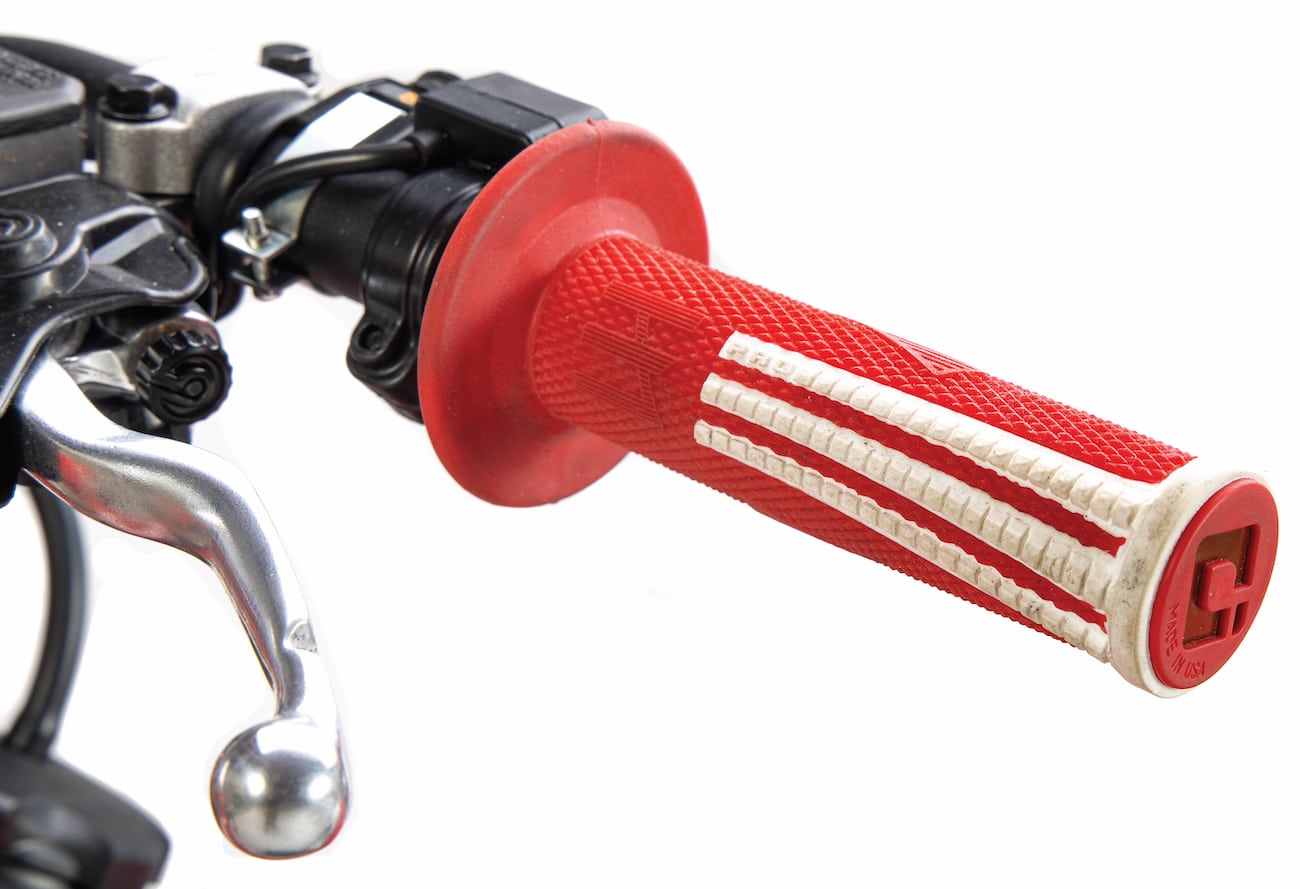 ODI Podium Flight handlebars are mated to Emig Pro V2 lock-on grips for the ultimate in control.
ODI Podium Flight handlebars are mated to Emig Pro V2 lock-on grips for the ultimate in control.
WHAT DOES IT COST?
The Cylinder Works engine kit takes the GasGas MC350F from 349.7cc to 366cc. The $720.95 big-bore kit comes with a brand-new, cast cylinder, 2mm-larger Vertex piston kit and Cometic gaskets. It is a bolt-on kit that ups the bore from 88mm to 90mm. I didn’t touch the head, compression ratio or valves, but I did install a Boyesen Supercooler water pump to keep engine overheating under control (note that the Cylinder Works engine kit did not run hot, but I tend to abuse the rev limiter and clutch in unison). The engine was one and done in an afternoon. It was as easy as changing a piston.
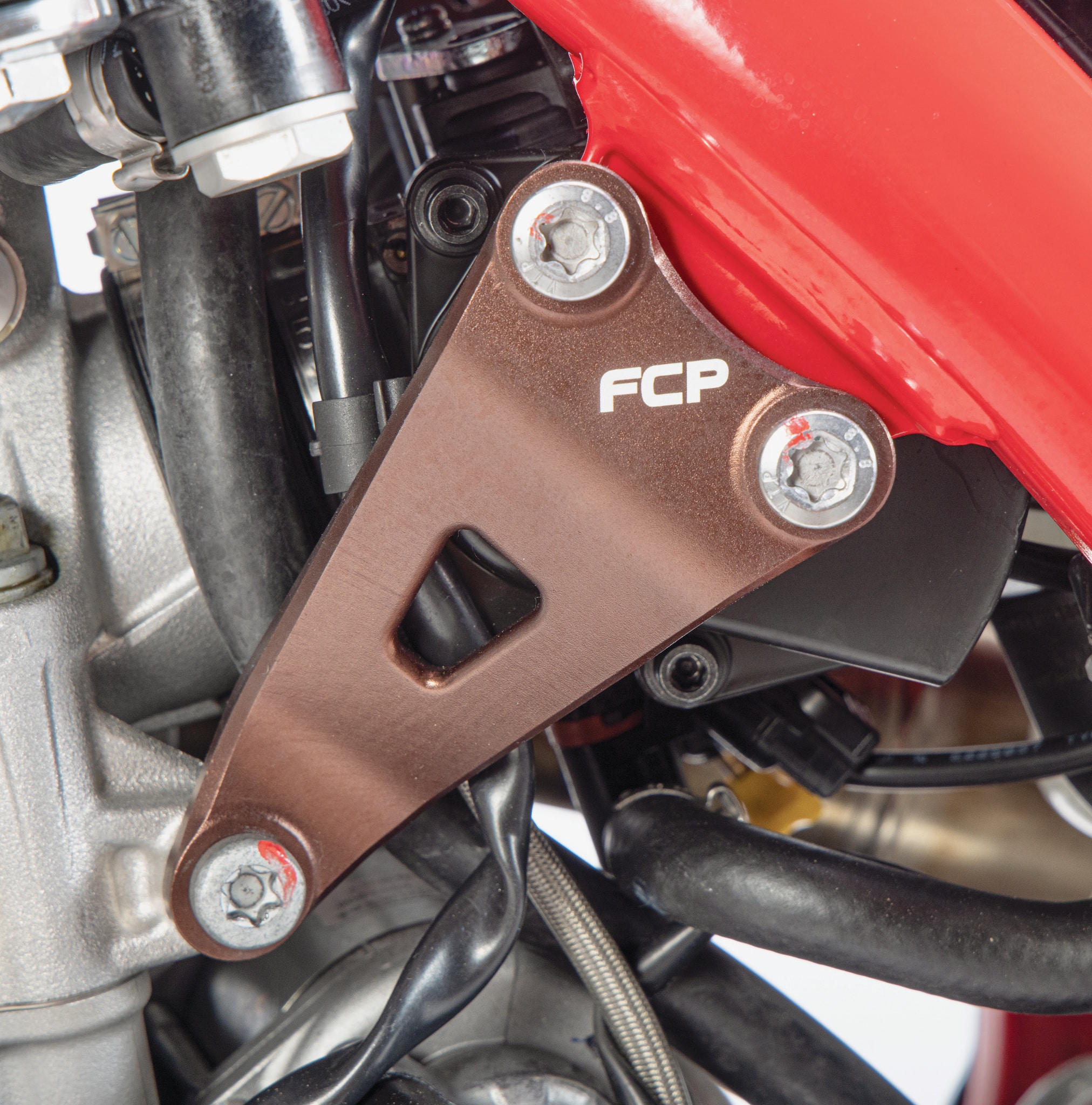 To increase chassis resilience, the stock headstays were replaced with FCP headstays. They improved front-end feel.
To increase chassis resilience, the stock headstays were replaced with FCP headstays. They improved front-end feel.
WHAT ABOUT MAPPING?
Both Twisted Development’s Jamie Ellis and KTM Factory engine builder David O’Connor guaranteed that it would run better than a 350 with the stock ignition (I had already installed the accessory map switch to access the aggressive map, Traction Control and Launch Control), but they said that if I needed more snap off the bottom or increased rev on top, I should install a Vortex X10 ignition box with Twisted Development mapping.
David said he had built a lot of 336s for his friends and that the Twisted map was perfect. I didn’t doubt Jamie and David, but I doubted my skill level and opted to swap back and forth between the stock GasGas ECU and the Vortex. The stock black box felt broader through the middle and, in the process, gave up the Vortex’s low-end snap and more responsive high-rpm rev. Since GasGas black boxes can be swapped in five minutes, I used the Vortex on deep, loamy tracks and the stock box for hard-packed summer days. It should be noted that the Vortex swap cost more than the 366cc engine kit.
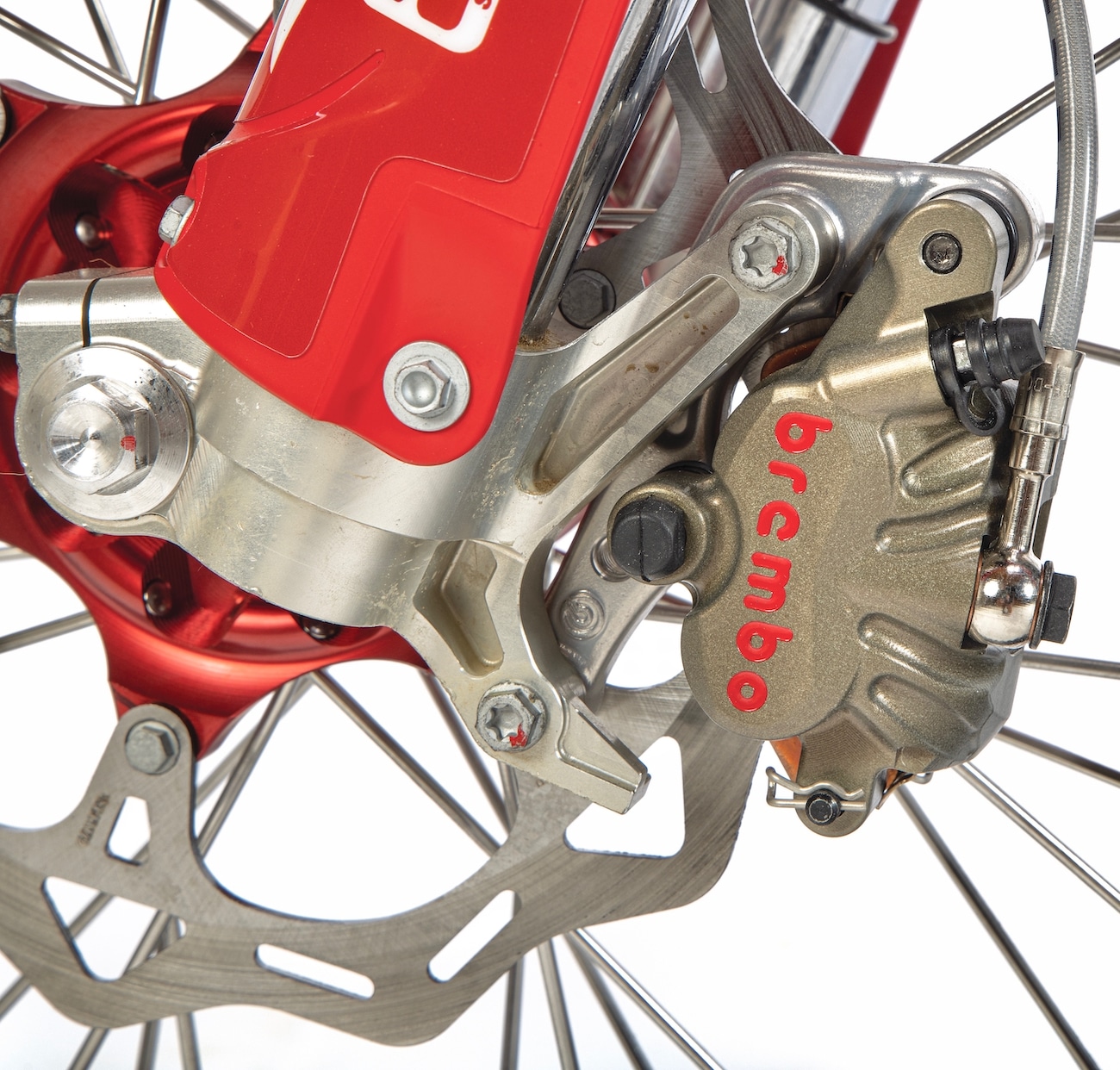 Brembo SXS brake calipers were works part a few years ago. Because of their increased rigidity, they magnify the pucker power. The cost? A hefty $2140.
Brembo SXS brake calipers were works part a few years ago. Because of their increased rigidity, they magnify the pucker power. The cost? A hefty $2140.
FIXING THE CHASSIS
I was happy with the stock 2023 GasGas MC350F chassis/suspension setup, except that I thought it was too soft for my weight. Then, when duty called and I was assigned to test MXA’s 2023 Husqvarna FC350, I realized immediately that the Husky cornered better. I knew from extensive testing that the GasGas’ forged aluminum triple clamps weren’t as accurate at turn-in as the stiffer CNC-machined billet triple clamps on the Husky FC350. Since Power Parts offers a set of red-anodized Factory split triple clamps on the 2023-1/2 GasGas Factory Edition, I mounted those.
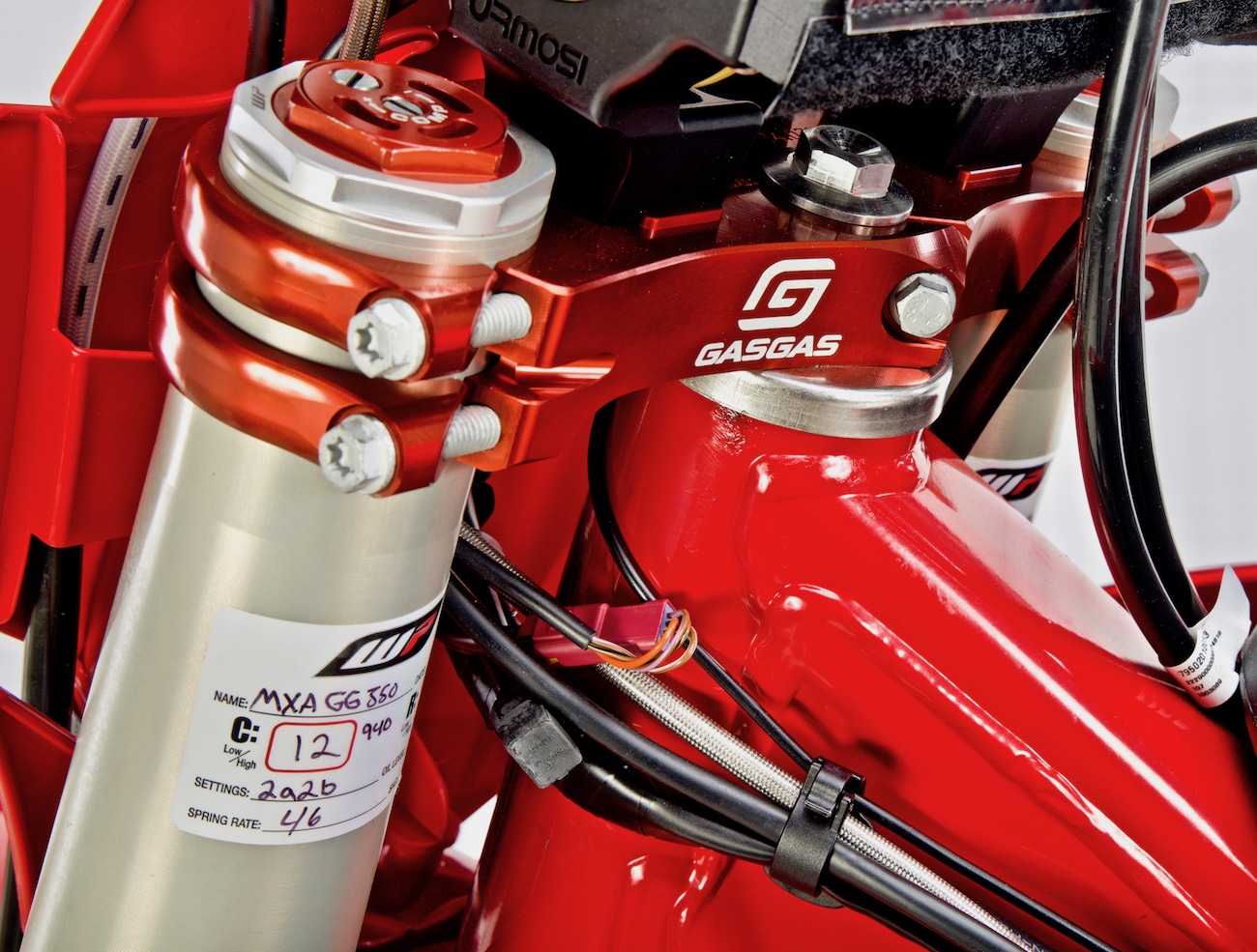 GasGas has red anodized split triple clamps in their parts catalog.
GasGas has red anodized split triple clamps in their parts catalog.
Additionally, I loved Husqvarna’s lowered suspension, and since my plan included having WP refurbish my existing Cone Valve coil-spring forks and Traxx shock for the MC366F, I had them shorten the forks by using Husqvarna internals, cartridge rods and fork tubes.
My Traxx shock didn’t need any internal changes because the majority of the lowering of Husqvarna’s rear suspension came from longer link arms to drop the rear of the MC366 1 inch and a revised bell crank that worked with the linkage to deliver the same rising rate as on a KTM. The Traxx shock did need a taller seal head cap on top of the shock body to limit the stroke of the shock by 6mm and to keep the rear tire from hitting the rear fender.
Dennis Stapleton volunteered to help me get the fork and shock valving dialed in to be as plush as possible, especially since I was upping the rear shock spring from the stock GasGas 42 N/mm spring rate to a stiffer 45 N/mm. It took us three re-valves with WP’s help to get where the two of us agreed we were in the sweet spot. Dennis’ personal tastes favor really stiff Pro suspension, but he had spent three years as a KTM test rider and knew how to set up the forks and shock for Vet riders. To cross-check our settings, we would have other MXA test riders race it between re-valves for outside feedback.
In short, the four things I added to the chassis were more rigid triple clamps, shortened Cone Valve forks (with 4.6 N/mm fork springs), a Husqvarna rising-rate shock linkage and a stiffer 45 N/mm shock spring (replacing the GasGas’ stock 42 N/mm spring). Paradoxically, I made it softer, lower and stiffer from one end to the other.
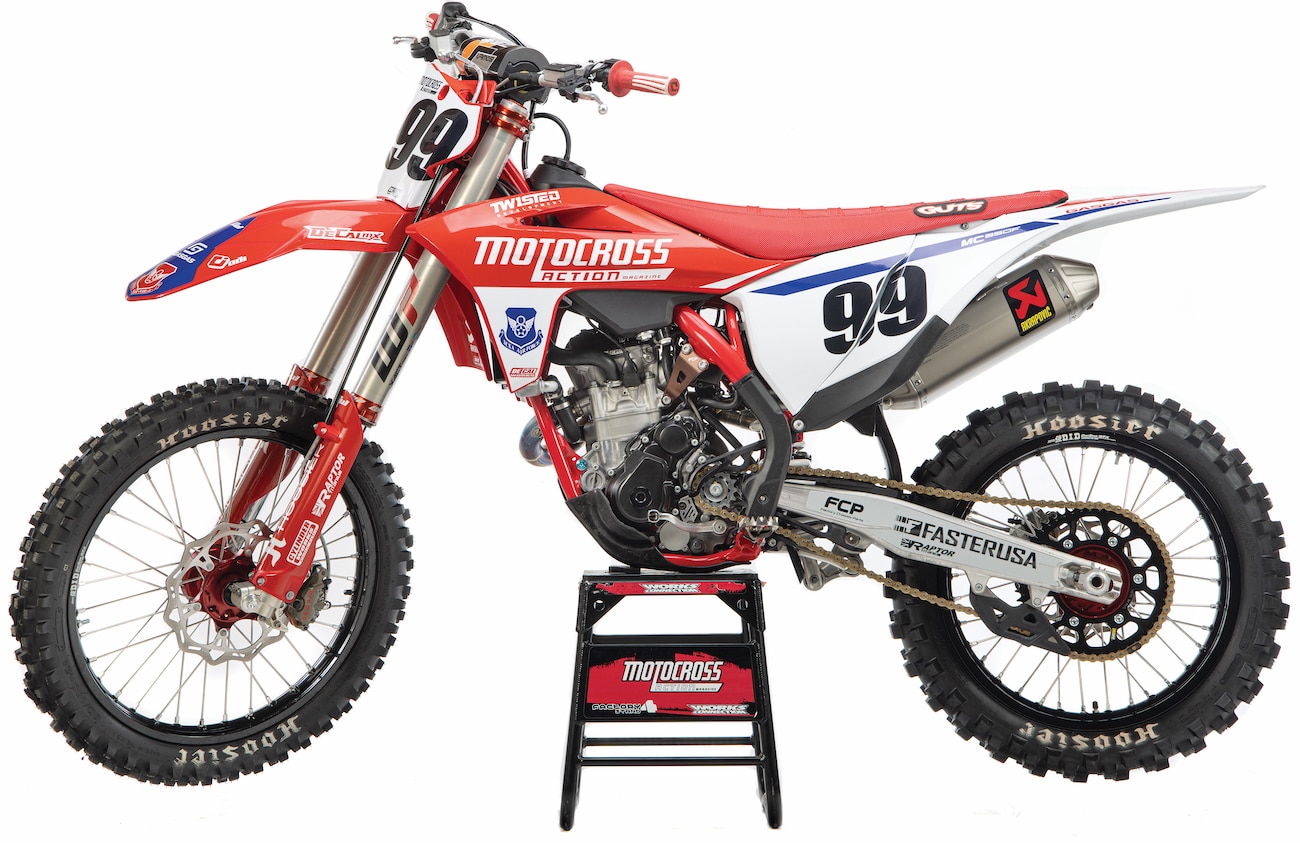 Faster USA built the ultra-strong wheels, Power Parts supplied the red-anodized triple clamps, the red/white plastic is from a 2022 GasGas EX350, the red pleated seat is by Guts, and the graphics are from Decal Works.
Faster USA built the ultra-strong wheels, Power Parts supplied the red-anodized triple clamps, the red/white plastic is from a 2022 GasGas EX350, the red pleated seat is by Guts, and the graphics are from Decal Works.
THE STUFF THAT GOES AROUND
When the MXA wrecking is racing our collection of KTM, Husqvarna and GasGas test bikes, we spend beaucoup time checking for loose spokes. This is time well spent because the spokes on the Austrian wheels are always loose, but we found a better solution in high-end aftermarket wheels, which I got from Faster USA. They laced Faster USA red-anodized hubs to black-anodized D.I.D ST-X rims with Excel spokes and nipples. The hubs are CNC-machined from solid billet U.S.-made aluminum, and when finished, they accept the stock GasGas spacers, bearings and seals.
On the new wheels, I mounted Hoosier IMX25 (C100) tires. I chose an 80/120 in the rear. I would usually prefer an 80/110 on the rear for more accurate cornering and less climbing out of ruts, but Hoosier’s 120 is closer to a 110 than a typical 120. For the front, I chose an 80/100 IMX25S.
Stopping the wheels from spinning are Factory SXS Works brake calipers (front and rear). These are actual works brakes off the KTM race team bikes from a few years ago. The SXS brake calipers are machined from high-strength aluminum, not cast, which makes the calipers stiffer to keep them from flexing under hard braking for more precise pucker power. When you have $2140 worth of brake calipers on your bike, you are as much focused on stopping as you are on going.
 In a nutshell, MXA’s GasGas 366F is lower, plusher, torquier and better suspended. It’s not a brutish 450 or a high rpm 250—it’s right in the middle.
In a nutshell, MXA’s GasGas 366F is lower, plusher, torquier and better suspended. It’s not a brutish 450 or a high rpm 250—it’s right in the middle.
THINGS THAT TOUCH YOU & VICE VERSA
There are always lots of compromises when you are trying to fine-tune the fit and feel of your race bike. Here are the miscellaneous changes I made to suit my tastes, needs and reduced speed.
(1) FCP. I ran FCP’s flexier head stays, tapered titanium front motor mount bolt and titanium footpeg pins in an effort to feed more resilience into the chassis.
(2) Urmosi. The Urmosi Soft Bar mounts are an elastomer-controlled set of handlebar mounts that retrofit on standard triple clamps. They differ from other energy-absorbing bar mounts, such as the Neken SFS, Xtrig PHDS and Flexx bars, in that the Urmosi soft bar mounts don’t just work in a downward motion in line with the forks but damp out vibrations, impacts and chatter bumps over 360 degrees of motion. They take the harshness out of every kind of bump. The MXA test riders laughed at me for running the odd-looking circular bar mounts, but once they rode with them, they changed their tune. Urmosi is perfect for Vets, not so much for Pros.
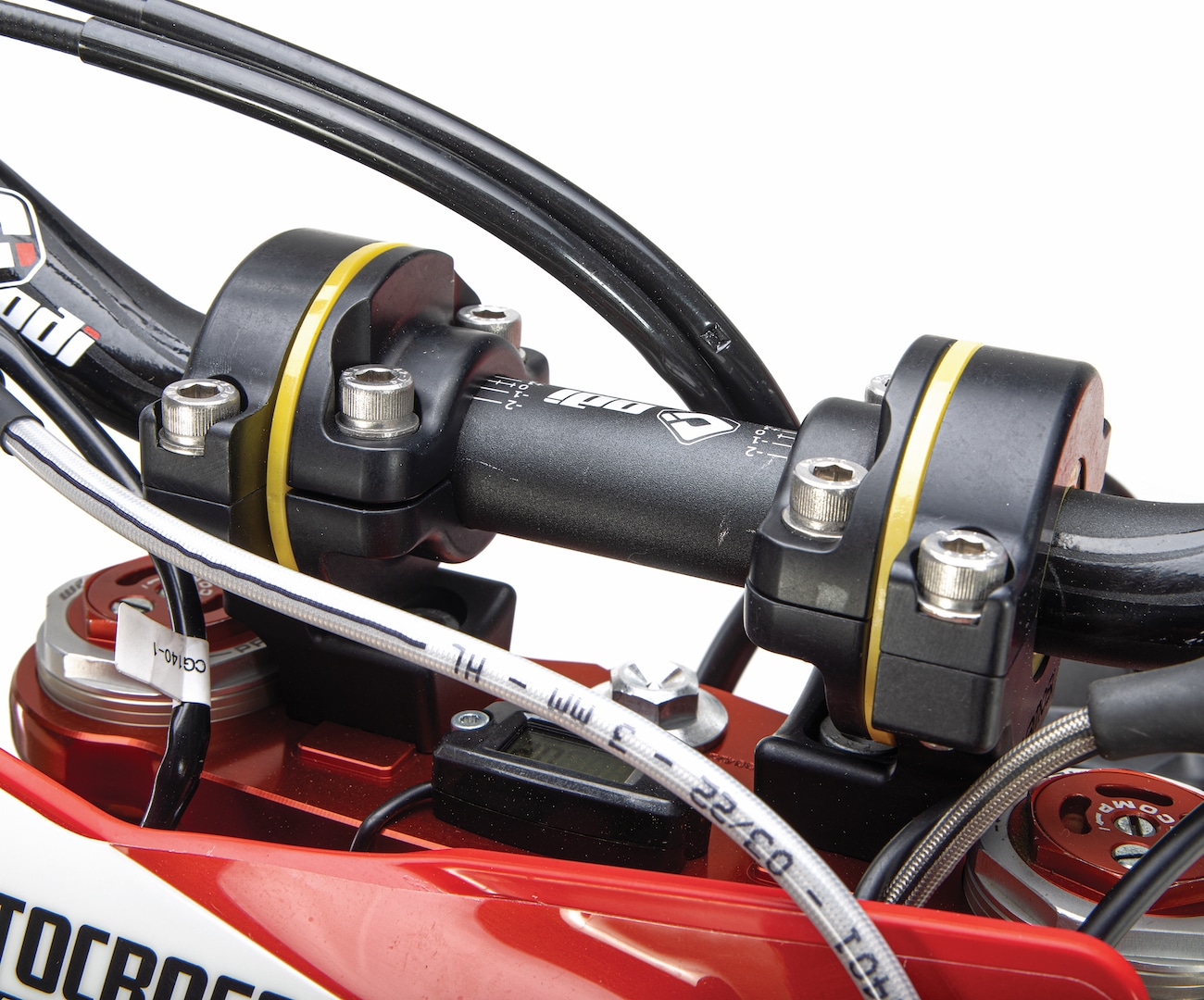 The cylindrical Urmosi bar mounts house elastomer donuts that lessen vibrations, jolts and numb hands. They look strange but work great.
The cylindrical Urmosi bar mounts house elastomer donuts that lessen vibrations, jolts and numb hands. They look strange but work great.
(3) ODI. I changed out the stock Neken silver handlebars because they were too tall when used with the Urmosi bar mounts, which added a 1/2 inch of height. I switched to lower and straighter ODI Podium Flight over-size bars (model 602) and Emig Pro V2 lock-on grips.
(4) Power Parts map switch. GasGas motocross models come with only one map choice. Well, actually, the ECU has two maps plus Traction Control and Launch Control. They are just not accessible unless you buy the Power Parts map switch. I could use the map switch with the stock black box or to access the two maps that Twisted Development put in my Vortex X10 ECU.
(5) Boyesen. Along with the Boyesen Supercooler water pump, I added an investment-cast Boyesen Factory Racing clutch cover. It is nicer looking than the roughly cast stocker and is narrower.
(6) Plastic. Everybody loves red motorcycles, but I think that the Honda and GasGas are too red. I ordered 2022 GasGas EX350F plastic because it has white side panels, a white rear fender and the bottom half the radiator wings are also white. I like the white, because it makes the red stand out. I also put on a Power Parts Factory skid plate because I looked at the bottom of my frame rails after last year, and they looked like they had been worked over with a ball-peen hammer.
(7) DeCal Works. I sent Decal Works a rather crude drawing of what I wanted my GasGas MC366F graphics to look like, and they nailed it. Best of all, they sent me a proof of the design before they printed it so I could make any changes I wanted. I asked them to change the color of the MXA Air Force logo on the radiator shrouds from red to blue, because I felt there was too much red.
(8) Seat. I went with a pleated red Guts seat cover. The stock seat cover is a little too slippery. I wanted more traction, but not too much. The Guts seat was just right. One thing I learned as I got older is that I only stand up when absolutely necessary, and I sit a lot more than when I was young. The pleats keep me in place.
(9) Raptor. I don’t actually like sharp footpegs. I’m the kind of rider who wears the inside of my boots out before I put any wear out the soles. I move my feet around a lot and never keep them in one place for very long. I ride light on the bike (funny, because I’m not light). I agreed to try Raptor titanium footpegs, even though looking at them scared me. I did returned to the stock pegs after a few races.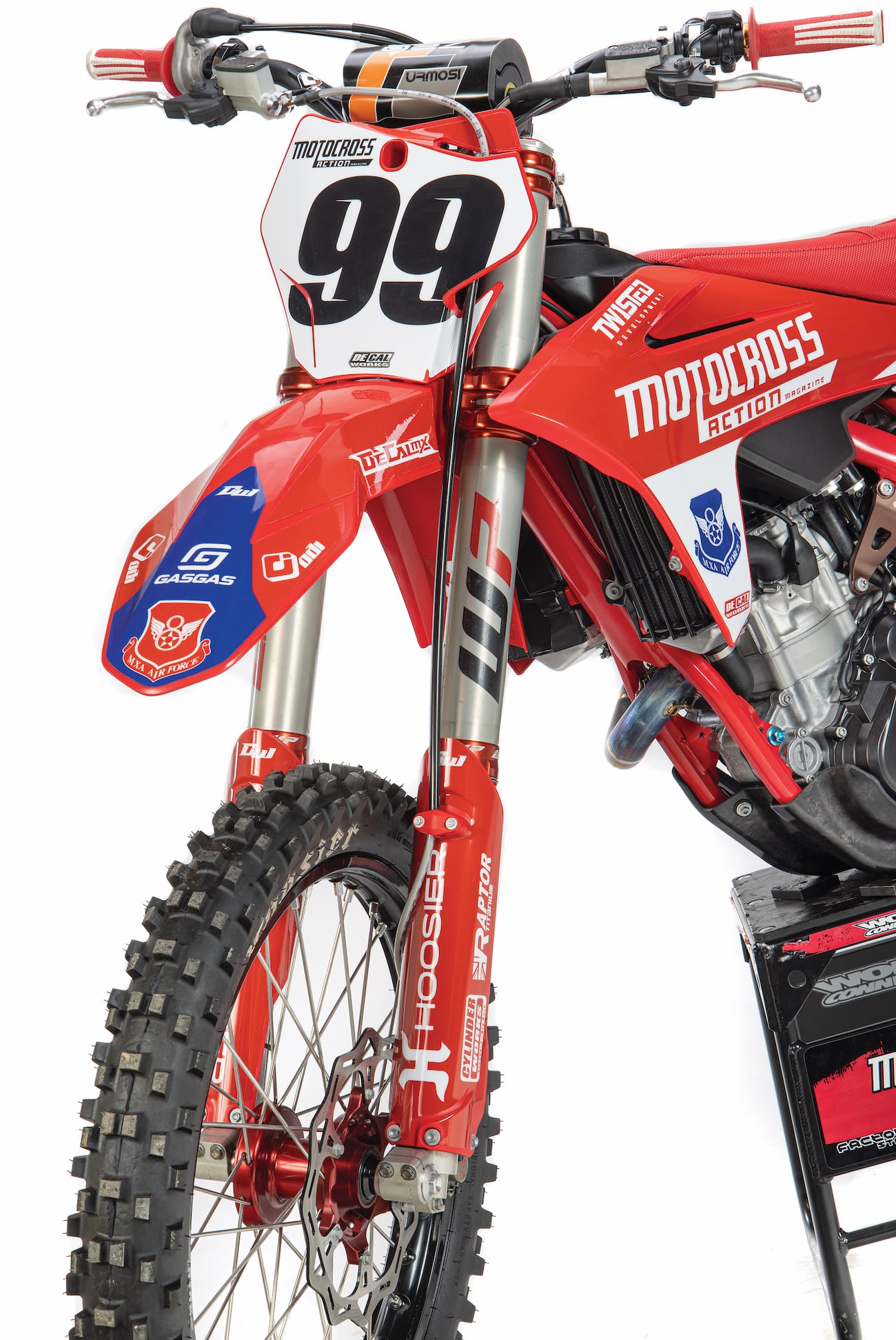 The WP rebuilt my older Cone Valve forks with 2023 Husqvarna internals to make them 10mm shorter to work with the lower Husky shock linkage.
The WP rebuilt my older Cone Valve forks with 2023 Husqvarna internals to make them 10mm shorter to work with the lower Husky shock linkage.
“I DIDN’T HAVE TO BE A ROCKET SCIENTIST TO BUILD THE PERFECT VET RACE BIKE. I JUST HAD TO BE HONEST WITH MYSELF. I HAD TO FORGET WHAT THE MUCH YOUNGER JODY LIKED AND ADDRESS A NEW LIST OF PRIORITIES.”
I didn’t have to be a rocket scientist to build the perfect Vet race bike. I just had to be honest with myself. I had to forget what the much younger Jody liked and address a new list of priorities.
First, I didn’t want to bolt stuff on my project MC366F just because someone anodized it. I wanted changes that worked, regardless of their status quotient.
Second, I wanted an easy-to-ride, broader, midrange powerband that would allow me to short-shift mid-corner yet still pump out 450-style peak power when needed.
Third, I wanted a lower seat height so that I could touch the ground, not just on the starting line, but when I had to dab a foot when the front end stepped out on corner exits.
Fourth, I wanted suspension that absorbed blows instead of my body having to absorb them. I didn’t need Supercross-stiff damping at the end of the stroke, because a seat in the mezzanine section of the stadium was as close as I was going to come to big doubles. Yet, I didn’t want it soft and divey, just plush in the braking bumps and progressive enough to hold up if I accidentally got too much air.
Fifth, I didn’t want a 233-pound pig, especially given that every aftermarket part you add to a bike raises the heft. I felt it was best to start with the lightest bike, which is what the 2023 GasGas MC350F is, and add weight where I wanted it (in my case, the WP Cone Valve forks were my concession to pork, and my GasGas MC366F was 8 pounds under the weight of a typical 450—with no serious effort made to save weight).
Final word, do I think every Vet rider should build a 2023 GasGas MC366F Jody Edition? Heavens to Murgatroyd, no. They just shouldn’t build a bike suited to an AMA Pro if they aren’t one. Are you one?





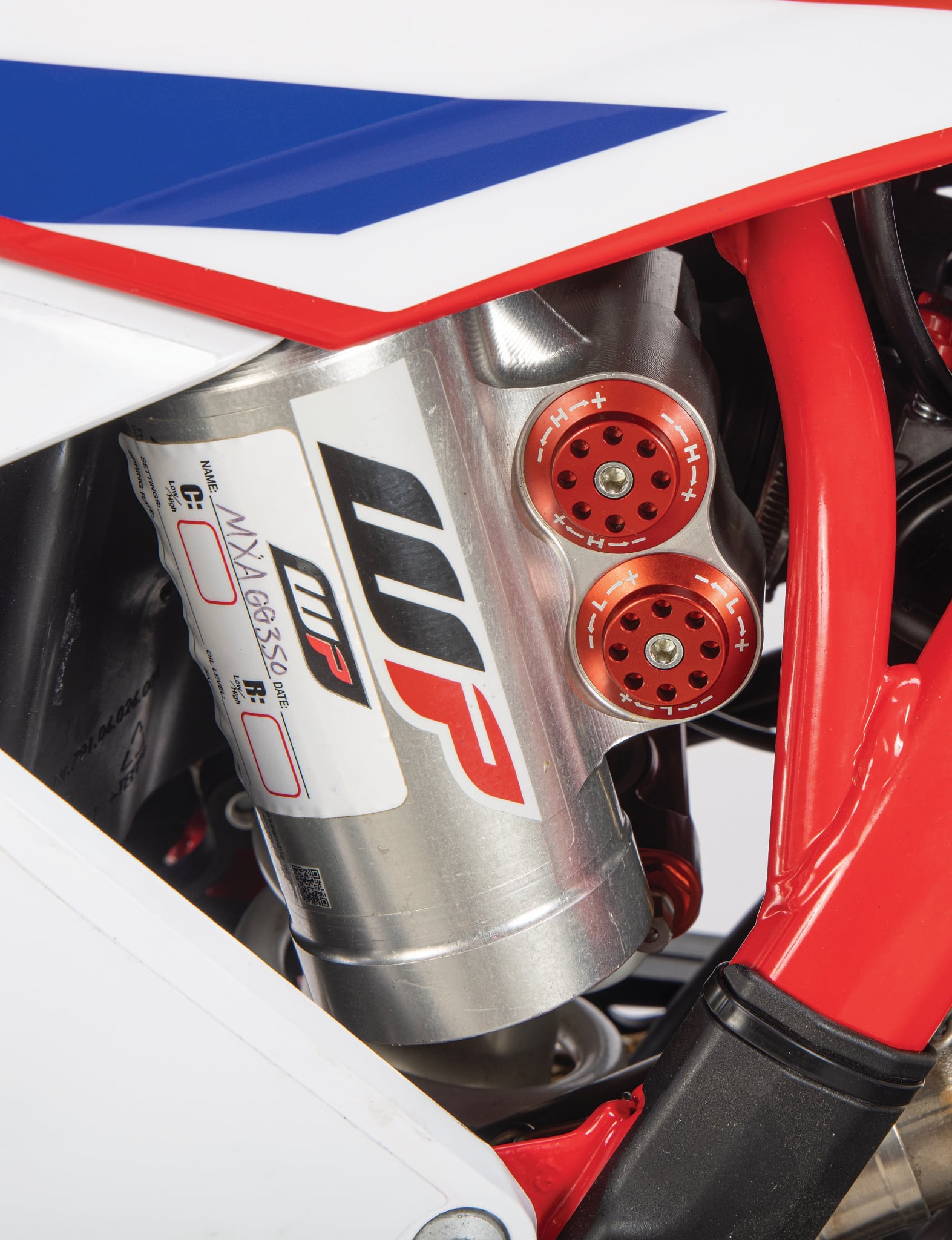
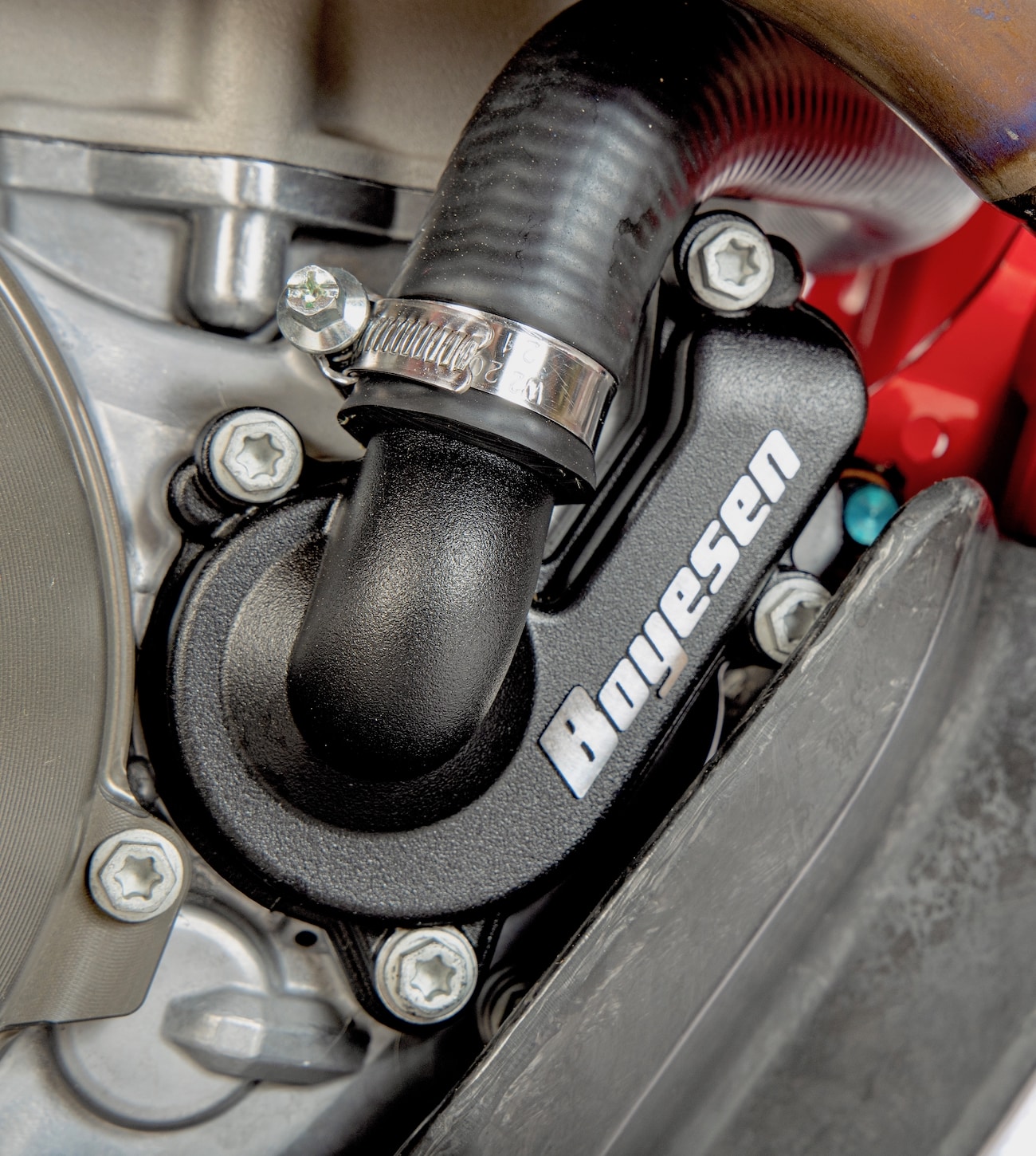
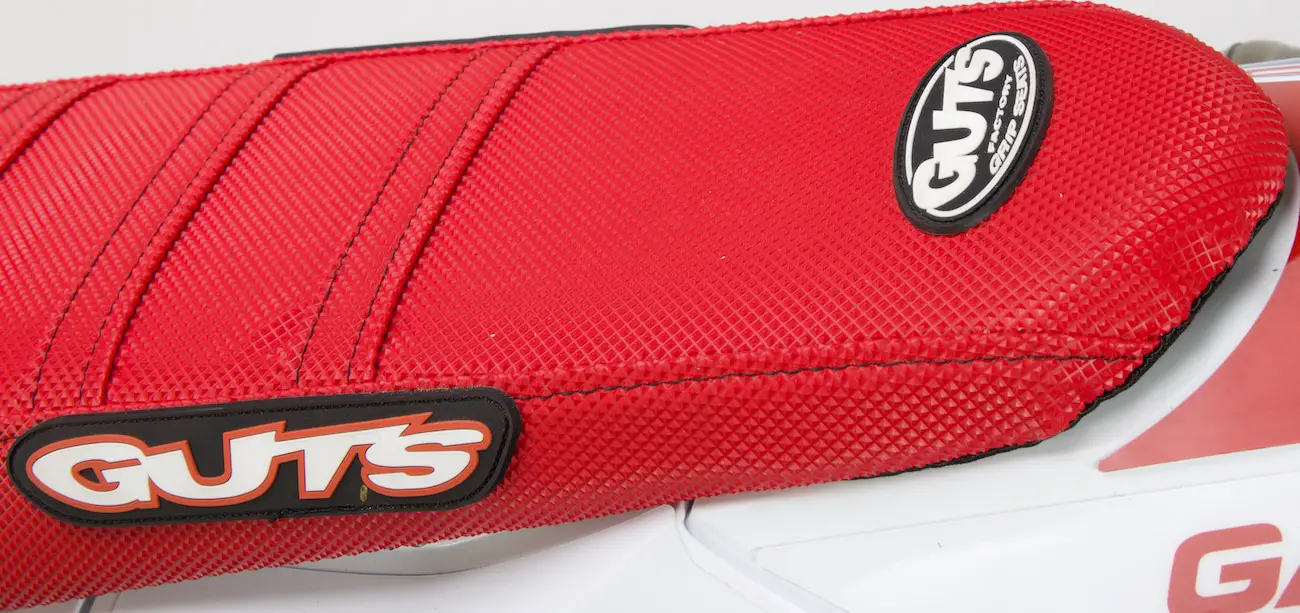
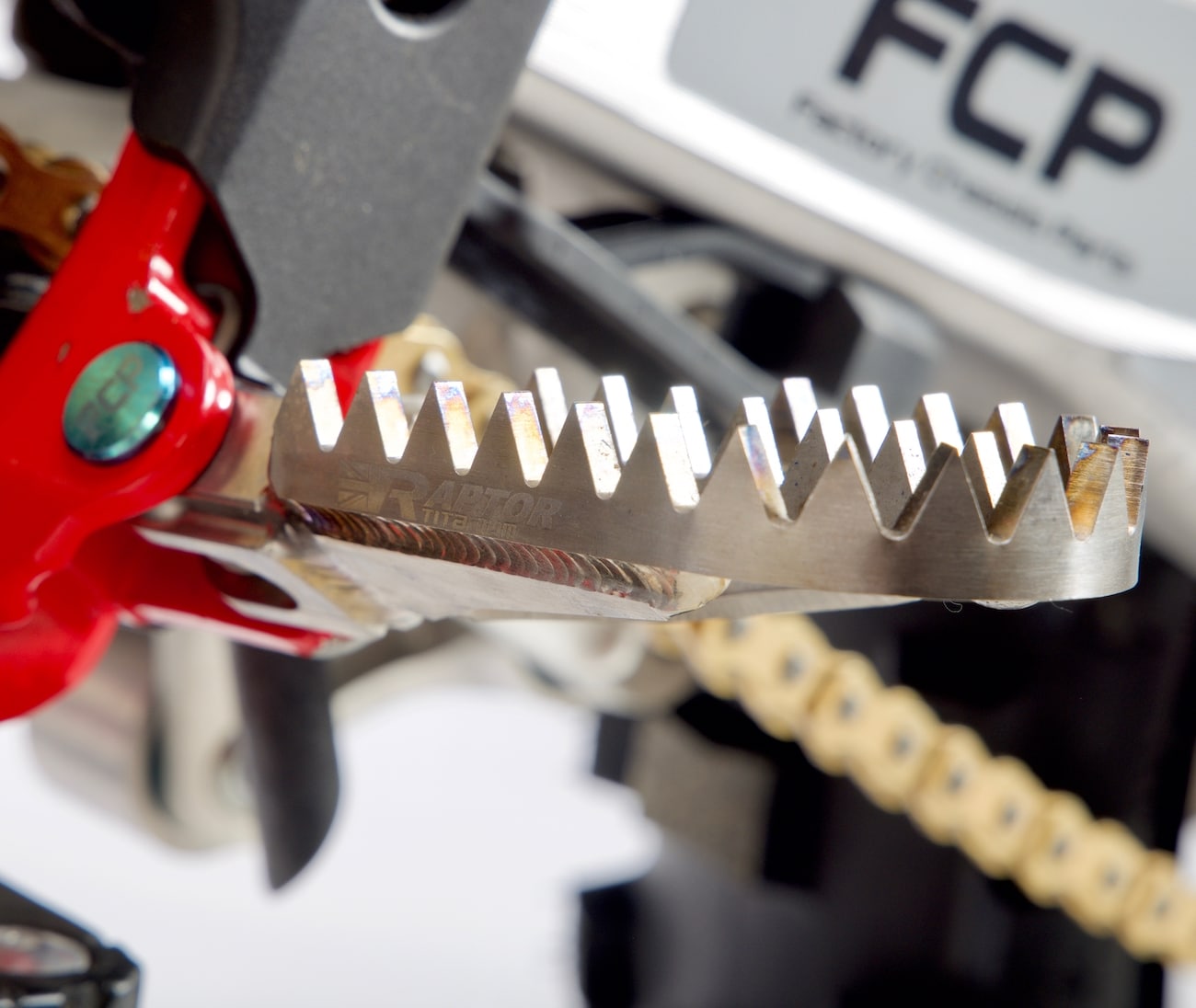




Comments are closed.